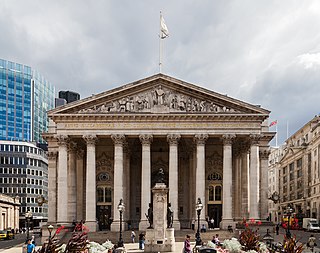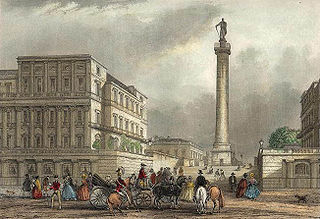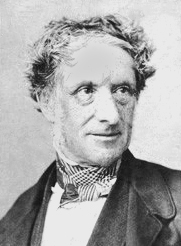
Sir Francis Leggatt Chantrey was an English sculptor. He became the leading portrait sculptor in Regency era Britain, producing busts and statues of many notable figures of the time. Chantrey's most notable works include the statues of King George IV ; King George III (Guildhall), and George Washington. He also executed four monuments to military heroes for St Paul's Cathedral, London. He left the Chantrey Bequest for the purchase of works of art for the nation, which was available from 1878 after the death of his widow.

Apsley House is the London townhouse of the Dukes of Wellington. It stands alone at Hyde Park Corner, on the south-east corner of Hyde Park, facing towards the large traffic roundabout in the centre of which stands the Wellington Arch. It is a Grade I listed building.

The Marble Arch is a 19th-century white marble-faced triumphal arch in London, England. The structure was designed by John Nash in 1827 as the state entrance to the cour d'honneur of Buckingham Palace; it stood near the site of what is today the three-bayed, central projection of the palace containing the well-known balcony. In 1851, on the initiative of architect and urban planner Decimus Burton, a one-time pupil of John Nash, the arch was relocated to its current site, near the northeast corner of Hyde Park, so that expansion of Buckingham Palace could proceed.

The Royal Exchange in London was founded in the 16th century by the merchant Sir Thomas Gresham on the suggestion of his factor Richard Clough to act as a centre of commerce for the City of London. The site was provided by the City of London Corporation and the Worshipful Company of Mercers, who still jointly own the freehold. The original foundation was ceremonially opened by Queen Elizabeth I who granted it its "royal" title. The current neoclassical building has a trapezoidal floor plan and is flanked by Cornhill and Threadneedle Street, which converge at Bank junction in the heart of the city. It lies in the Ward of Cornhill.

Sir John Robert Steell was a Scottish sculptor. He modelled many of the leading figures of Scottish history and culture, and is best known for a number of sculptures displayed in Edinburgh, including the statue of Sir Walter Scott at the base of the Scott Monument.

The Duke of York Column is a monument in London, England, to Prince Frederick, Duke of York, the second son of King George III. The designer was Benjamin Dean Wyatt. It is sited where a purposefully wide endpoint of Regent Street, known as Waterloo Place and Gardens, meets The Mall, between the two terraces of Carlton House Terrace and their tree-lined squares. The three very wide flights of steps down to The Mall adjoining are known as the Duke of York Steps. The column was completed in December 1832, and the statue of the Duke of York, by Sir Richard Westmacott, was raised on 10 April 1834.

Sir Richard Westmacott was a British sculptor.

Wellington's Column, or the Waterloo Memorial, is a monument to the Duke of Wellington standing on the corner of William Brown Street and Lime Street, Liverpool, Merseyside, England. It is recorded in the National Heritage List for England as a designated Grade II* listed building.

The Wellington statue in Aldershot, England is a monument to Arthur Wellesley, 1st Duke of Wellington, victor at the Battle of Waterloo and later prime minister of the United Kingdom. Sculpted by Matthew Cotes Wyatt, it was the largest equestrian statue in Britain when it was unveiled at its original location on the Wellington Arch at Hyde Park Corner in 1846.

The Machine Gun Corps Memorial, also known as The Boy David, is a memorial to the casualties of the Machine Gun Corps in the First World War. It is located on the north side of the traffic island at Hyde Park Corner in London, near the Wellington Arch, an Equestrian statue of the Duke of Wellington, the Royal Artillery Memorial, the New Zealand War Memorial, and the Australian War Memorial.

The fourth plinth is the northwest plinth in Trafalgar Square in central London. It was originally intended to hold an equestrian statue of William IV, but remained empty due to lack of funds. For over 150 years, its use was debated; in 1998, the Royal Society for the encouragement of Arts, Manufactures and Commerce (RSA) commissioned three contemporary sculptures to be displayed temporarily on the plinth. Shortly afterwards, Chris Smith, Secretary of State for Culture, Media and Sport, commissioned Sir John Mortimer to seek opinions from public art commissioners, critics and members of the public as to its future. Mortimer's final report recommended that there continue to be a rolling programme of commissioned temporary artworks rather than settle permanently on one figure or idea.
George Gammon Adams was an English portrait sculptor and medallist, noted for his statue of General Charles Napier in Trafalgar Square.

The statue of Thomas Munro is an equestrian statue of Thomas Munro, 1st Baronet, Major-General in the British Army and Governor of Madras from 1820 to 1827, located in the city of Chennai, India. The bronze statue sculpted by Francis Chantrey in the United Kingdom in 1834 and shipped to Madras in 1839, is one of the popular landmarks in Chennai. The absence of stirrups is one of the peculiarities of the statue and for this reason, it is also referred to as "The Stirrupless Majesty".

The equestrian statue of Arthur Wellesley, 1st Duke of Wellington located outside the Royal Exchange, now known as the Gallery of Modern Art, Glasgow, Scotland, is one of Glasgow's most iconic landmarks.

The statue of George IV in Trafalgar Square, London, is a bronze equestrian statue by Sir Francis Legatt Chantrey. It depicts the King dressed in ancient Roman attire and riding bareback. The sculpture was originally designed to sit on top of the Marble Arch at the entrance to Buckingham Palace, but was placed in its current location following the King's death.

An equestrian statue of Arthur Wellesley, 1st Duke of Wellington, stands on the north side of Hyde Park Corner, London. The open space in which it stands, now the centre of a large roundabout, was once called Wellington Place.

The South Bank Lion is an 1837 sculpture in Central London. Since 1966 it has stood next to County Hall, on the South Bank of the River Thames. It is a significant depiction of a lion, along with the four that surround Nelson's Column in Trafalgar Square just across the river.

The equestrian statue of Prince George, Duke of Cambridge is a life-size memorial by Adrian Jones, installed in Whitehall, London, England.

The statue of James Henry Greathead, designed by James Butler, is installed outside the Royal Exchange, where it conceals a ventilation shaft. It was erected in 1994 on a traffic island in the middle of Cornhill, London, with traffic passing to either side, similar to the statue of Prince Albert at Holborn Circus. The London Troops War Memorial is nearby.





















